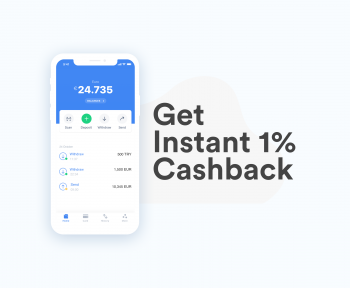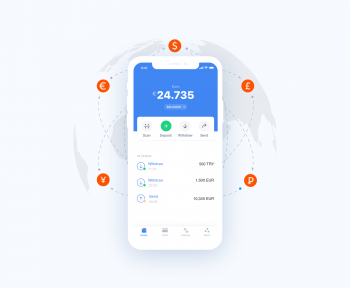Anyone who has ever had to make financial transactions in the European Union has most definitely heard of SEPA. An acronym for Single Euro Payments Area, SEPA has been making waves in the EU financial market ever since its initial release back in 2008.
Now processing 46 billion transactions every year, SEPA is a European Payment Council-regulated initiative whose features are still not clear to many individuals, especially those who are outside of the EU zone — and some other users even though they are regularly using it to send and receive money.
Well, we’re here to cover everything you need to know about what SEPA is, its uses, SEPA countries, benefits, and how users can amplify their SEPA experiences with Jeton. So, join us as we explore the world of SEPA.
What is the SEPA Initiative?
In the most basic sense, the Single Euro Payments Area (SEPA) is an EU initiative to streamline cashless payments and ensure transaction consistency among and between 36 EU member countries.
The History of the SEPA Payments
The history of SEPA is tightly woven into the fabric of the European Community and the European Union’s evolution. That’s mainly because SEPA, or the Single Euro Payment Area, has an important mission: to make payments and transfers easier, more uniform, and faster across member states, all while harnessing the integrating power of the euro and implementation of standardised payment frameworks.
Introduced in multiple stages, SEPA’s journey began with credit transfers in its initial release in 2008, soon followed by direct debits in 2009, and lastly, the game-changing instant credit transfers in 2017. Credit transfers, whether regular or instant, are defined by their ability to transfer funds from one account to another with ease. Direct debits, on the other hand, pivot around withdrawing funds from one account and crediting them to another account.
All developments around SEPA are guided by the Eurosystem, an organization comprised of the European Central Bank (ECB) and the national central banks of the eurozone member states. These national central banks provide the market structure necessary for their countries’ economic institutions and ensure that SEPA policies run effectively.
As we’ve mentioned above, the European Payments Commission (EPC) is the institution that is responsible for the regulation of payment methods used by payment service providers within the SEPA framework and for administering the clearing and settlement mechanisms.
With collaborative and steadfast organisations behind it, SEPA transfers act as a testament to the close-knit nature and the financial power of the EU.
A Real-Life Example of a SEPA Transfer
Let’s paint a picture of a real-life scenario where a SEPA transfer comes in handy. Think of a German student studying abroad in Spain. They need to pay their monthly rent for their apartment in Barcelona.
In the past, this might have been a complicated process involving international bank transfers, currency conversion fees, and delays in the process. However, now thanks to SEPA, the student can easily transfer funds from their German bank account to their Spanish landlord’s account through a SEPA bank transfer.
The student initiates the payment online through their German bank’s website or mobile app. They enter the landlord’s IBAN (International Bank Account Number) and the amount of rent due.
As both Germany and Spain are part of the SEPA region, the payment is processed as a domestic transaction despite the cross-border nature of the transfer. As a result, the student does not have to worry about currency conversion or higher fees.
The payment reaches the landlord’s Spanish bank account within one business day, just like a local payment would. This streamlined process ensures that the student’s rent is paid on time and without unnecessary complications, highlighting the convenience and efficiency that SEPA brings to cross-border transactions within Europe.
How to Open a SEPA Bank Account
Whether you are EU local or from outside of the SEPA region, opening a SEPA bank account can be a breeze thanks to modern fintech solutions and your trusted payment partner Jeton. Let’s take a look.
For EU Residents:
If you are a member of the European Union (EU), you are in luck. If you open a bank account within the EU, that said account will automatically become a SEPA bank account. No more steps, no commotion — SEPA is just part of the banking package.
Important note: While Europe boasts many banks, not all of them are members of SEPA. So, when you start looking into your SEPA bank account, make sure you choose a bank that is part of the SEPA network.
For Non-Residents:
Even if you are not an EU resident, you can still create SEPA bank accounts online and remotely. That’s where Jeton comes in! However, you should ready up some identification requirements to create your SEPA account. This ensures your compliance and that you are good to go.
From residents to travellers, SEPA bank accounts offer a convenient way to manage your funds across Europe. With the right payment service provider, you can easily navigate the world of SEPA payments.
SEPA Account Requirements
Online banking has become a game-changer in today’s fintech industry, especially for cross-border transactions. And with SEPA, you can create both personal and business accounts. However, there are some legal standards and prerequisites that each user should adhere to for a secure and seamless procedure that minimises the risk of money laundering.
While we have shared the requirements for each EU account, keep in mind that countries might have their own specific requirements.
SEPA Account Requirements for EU Businesses
EU-Based businesses who are looking to set up a SEPA account generally need to provide a physical address within the EU for their operations in addition to employee registration in an EU country. These businesses also need to make sure that they’re tax compliant in an EU country and must be able to provide a credit check reference to complete their SEPA registration.
SEPA Account Requirements for EU Individuals
To get an individual SEPA bank account within the EU, individuals should usually reach out to a specific bank to discuss their specific requirements. However, main requirements that most banks ask for include a passport-sized photograph, an up-to-date physical address, your company registration number, and an introductory letter from a bank or a representative.

Opening a SEPA Account Online with Jeton
In the digital age, getting a SEPA bank account has become incredibly easy wherever you might be located, thanks to modern financial systems such as Jeton. The beauty of this development is how inclusive it is — since you are not limited by nationality. This evolution in banking is engineered to simplify international payments worldwide.
To begin your journey to create a personal/business SEPA account with Jeton, head over to www.jeton.com/business. Fill out the necessary information to open your account, and make sure that it is accurate and complete. Next, provide the required certification of compliance as requested and identify yourself with ID authentication such as the Face ID. After your application goes through Jeton’s review and it’s accepted, you are now the holder of a SEPA account, even if you’re not residing in the SEPA region!
Opening a SEPA bank account is effortless and secure, especially when you choose Jeton. In line with the fast pace of digital banking, Jetton’s flexible structure ensures that international transactions are a breeze, catering to global businesses and individuals seeking cross-border financial solutions. Jeton’s commitment to speed and security makes accessing your SEPA account a hassle-free experience without compromising on robust safeguards.
Jeton’s prowess extends beyond simplicity. With over 70 currencies and numerous cryptocurrencies available, it allows you to operate in the currency of your choice, whether you are a multinational business working with markets or an individual involved in global financial activities. Jeton’s modern approach not only improves efficiency and security but also provides the ability to manage your financial services on your terms, beyond geographic barriers and currency limits.
What Types of SEPA Transfers Are There?
Now you’re probably wondering what the SEPA bank transfer types are. Navigating the banking world can sometimes feel like deciphering a foreign language, but fear not — as SEPA transfers are here to simplify the process. With three main different services to offer, let’s dive into the inner workings of SEPA Credit Transfer, SEPA Instant Credit Transfer and SEPA Direct Debit Transfer.
SEPA Credit Transfer: Easy Cross-Border Money Transfers
For those one-time transfers and all your basic transfer needs, the SEPA Credit Transfer comes to the rescue. It uses the mighty combination of IBAN (International Bank Account Number) and occasionally the BIC (Business Identifier Code) numbers of both the sender’s and recipient’s bank accounts.
If you were to transfer €1000 from your bank in Italy to a friend’s account in France, SEPA Credit Transfer would work similarly to a domestic money transfer. After you initiate the SEPA Credit Transfer, Your German bank deducts the money from your account, and the French bank deposits it to your friend’s account, all within one business day.
SEPA Instant Credit Transfer: Lightning-Fast Transfers
If speed is your top priority, SEPA Instant Credit Transfer will be your new best friend with its lightning-fast instant payments. Launched in November 2017, this SEPA service lives up to its name. Confirm a SEPA Instant Transfer, and voila — in less than 10 seconds, the funds are at the recipient’s disposal.
No intermediaries are involved; It is a direct route from the sender to the receiver’s bank account. Plus, you don’t have to worry about weekends or holidays; It’s available 24/7, 365 days a year. Just take a minute to make sure that both the sender and the receiver are SEPA Instant Transfer members before hitting send!
SEPA Direct Debit Transfer: For Recurring Payment Transfers
If you’re dealing with recurring payments, SEPA Direct Debit Transfer is exactly what you need. Monthly rent, utility bills, and loan payments; basically anything that you owe or need to pay on a regular basis can be handled with SEPA Direct Debit Transfer.
As with other SEPA transfers, IBAN and sometimes BIC come into play with this transfer type. But here’s the twist; unlike the traditional way of transferring money, the receiver is the one who initiates the transaction. They ask the sender’s permission to “withdraw” money from their account. The sender then signs an “order” to authorise this recurring transaction, and the payment becomes a breeze.
Two Sides of the SEPA Direct Debit Transfer: SEPA Core and SEPA B2B
There are two sides to the SEPA Direct Debit Transfer: SEPA Core and SEPA B2B. The SEPA Core Direct Debit Transfer appeals to individuals and is mandatory to use for all participating banks.
SEPA B2B Direct Debit Transfer, on the other hand, is designed for businesses. Although it’s not mandatory, banks can offer this service to their business customers within the SEPA framework. SEPA B2B Direct Debit Transfer composes a tailored melody for business operations, offering security, adaptability and reliability in one compatible package, making it a very popular option in the corporate world.
SEPA B2B Direct Debit Transfers: Enabling Business Transactions
In the world of business transactions, SEPA B2B Direct Debit Transfers shine as the go-to solution for corporate money transfers and tax obligations. Whether repaying loans, covering taxes, or making big purchases, these transfers play an important role in the corporate landscape.
SEPA Direct Debit B2B has critical differences from its counterpart SEPA Core Direct Debit Transfer. Mandated verification plays a vital role — before any payment can be initiated, the agreement must be registered with the debtor’s PSP (Payment Service Provider). This ensures validity and sets it apart from SEPA Direct Debit Core (SDD).
How Do SEPA Transfers Work?
Now that you know the types of SEPA transfers, let’s unravel how SEPA transfers work — and trust us when we say it’s not as complicated as it sounds. Here’s a simple guide to walk you through the process.
Step 1: Access Your Account
To get things started, log into your online bank account. This is where the SEPA magic begins.
Step 2: Identity Check
Sometimes a background check is required before you can process your SEPA transfers. This security precaution ensures you’re on top of everything with regulations like Know Your Customer (KYC) and Anti-Money Laundering (AML).
Step 3: Currency Conversion (or not)
If you are sending a currency other than euros, you can be faced with exchange fees. But if you already have your balance in Euros, you’re good to go!
Step 4: Set the Wheels in Motion
Time to make your SEPA transfer happen. Enter the recipient’s International Bank Account Number (IBAN) and/or any other required information. Confirm the amount you’ve sent, and you’re all set.
And that’s about it — the funds are on their way. Both your account and the recipient’s account will show the changes, just like they would in any other transaction. It’s always important to keep an eye on the balance, especially if there is a bank fee in the mix.
Which Countries are in the SEPA Region?
After all the EU exclusivity talks, we’re here to surprise you with the fact that the SEPA region has diverse communities and associations that extend beyond the Eurozone or the European Union.
It’s safe to say that the countries in SEPA aren’t confined to one corner. Although 36 countries belong to the SEPA group, not all of them wear the Euro or EU tag. For example, the UK, even after Brexit, is still among the SEPA countries providing fast transfers around Europe.
Surprises continue with non-EU SEPA countries. Originally members of the European Free Trade Association (EFTA), Iceland, Liechtenstein, Norway and Switzerland are among the SEPA countries but not members of the European Union. Not to mention Andorra, Monaco, San Marino, and the Vatican City State / Holy See, which are other SEPA members that are not EU countries.
Within the EU, there is a blend. France and other countries that use the euro currency, along with economically developed non-euro countries such as Iceland, Liechtenstein and Norway, form the European Economic Area (EEA).
And then there is the unique flair of EU member states having their own unique currencies — think Croatia and Poland. To further understand the power of SEPA, just remember the non-EU UK is also maintaining its connection with the SEPA region.
SEPA countries, where boundaries are broken and payments are consolidated, is creating a mix of nations, currencies and partnerships where the cross-border payment canvas keeps stretching far and wide.
The Advantages and Disadvantages of SEPA Transfers
By now, you can tell that SEPA offers many advantages to those looking for fast and seamless money transfers. Below, we’ve shared some of the main advantages followed by possible disadvantages of using SEPA transfers.
Advantages of SEPA Transfers
- Fast and Cost-Effective Flow
SEPA payments shine in terms of speed and cost-effectiveness. By bypassing various financial networks, these transactions help users enjoy faster transfer speeds and lower fees, making them wallet-friendly and time-efficient.
- Wide Coverage
SEPA’s extensive reach extends across 36 member states and serves a big chunk out of Europe’s 44 countries. As some of the SEPA countries are not part of the eurozone or the European Union, it shows that the impact of SEPA goes beyond official borders. With Jeton, even those who are not in the EU can create a SEPA account online and make use of the efficiency it offers.
- Traveler-Friendly
Frequent travellers find solace in SEPA. It allows jet setters to maintain a single bank account, no matter where they may roam. It’s a game changer for those hopping between countries, even if it’s for work or leisure.
- Reversible Transfers
Perhaps one of the best features of SEPA is its reversible transfers. The SEPA Direct Debit transaction comes with an 8-week protection net. Customers can reverse charges without an explanation in a feature called chargeback. This reassuring perk adds extra security to those opting for SEPA transfers.
Disadvantages of SEPA Transfers
- Traditional Methods
The bread and butter of SEPA lies in bank transfers and card payments, which are usually physical. While steps are being taken to integrate mobile payments, SEPA’s current support for smartphone-based transactions remains limited.
- Euro-Centric
Support for no-fee SEPA transfers is only available when you’re making transactions in euros. While the euro circulates in Europe, some member states have their own local currencies, which may require currency conversion before and after transactions, possibly resulting in nominal fees.
- Limited Global Reach
Without online payment providers such as Jeton, SEPA’s influence remains within Europe, leaving the rest of the world reliant on other payment services. What’s more, certain European countries and specific areas within them are still subject to SEPA ratification.
- Service Changes
SEPA’s role may vary between banks and countries. Although SEPA Direct Debit Core and SEPA Credit Transfer are the standard, not all banks may be able to offer options such as SEPA Direct Debit B2B and Instant Credit Transfer, resulting in a patchwork of available services.
Use SEPA for Your Cross-Border Transfers from Anywhere with Jeton!
With its numerous benefits and ease of use, SEPA is reshaping the European economy, processing billions of transactions each year ever since its inception in 2008. While Jeton stands as a bridge to this world, providing fast, secure, and inclusive access to SEPA services across borders around the world. With over 70 currencies available, Jeton empowers users to operate with their chosen currency, ensuring efficiency and flexibility in their financial activities.
SEPA’s transformative power extends to different types of transfers and catering to diverse needs. Whether it’s basic daily transfers, lightning-fast payments, or recurring transactions, SEPA aims to simplify cross-border transactions. While SEPA offers advantages such as cost-effectiveness, broad coverage, travel friendliness, and flexibility of services, it is important to acknowledge its limitations and make informed decisions to stay safe before making money transactions.
With Jeton’s commitment to simplicity, speed, and security, opening a SEPA account becomes a hassle-free experience. If you’re looking to set up your own SEPA account, look no further than Jeton’s customer-focused services to carry your financial transfers to new heights. Create your account with Jeton now to usher into a world where the potential of SEPA meets the convenience of Jeton’s modern payment systems.



